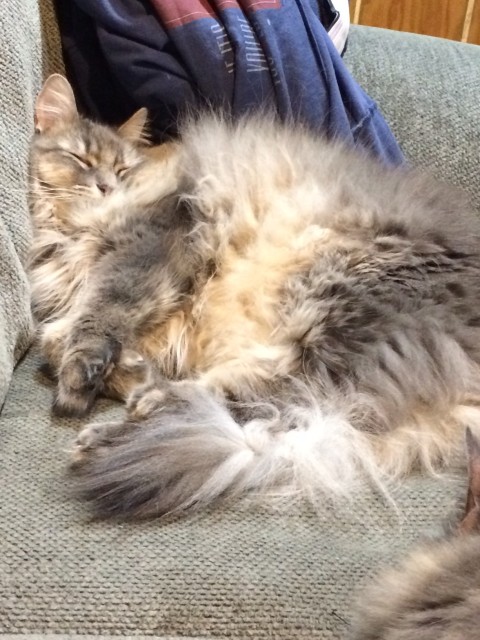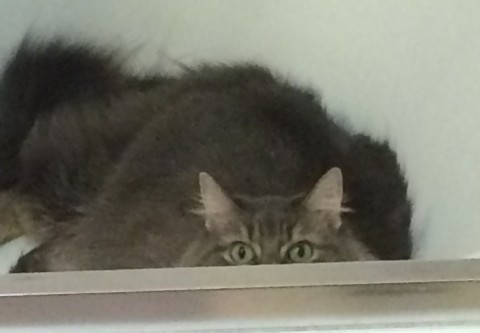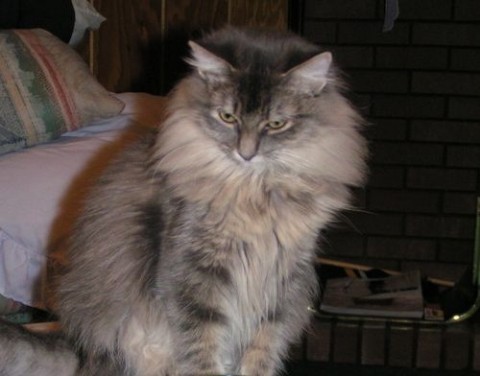This article was originally posted at Pawsitive Pet Parenting.
You may not have heard of chylothorax in cats. It’s a very rare condition, but still possible, even without cause. Two years ago, we noticed that our cat, Kali, was coughing quite a bit, and she sounded very congested with each episode. We also noticed that she seemed to be having a little trouble breathing, and that she got tired easily while playing.
We took her to Antioch Animal Hospital, and our vet first diagnosed a respiratory infection, even though her symptoms and x-rays weren’t quite right for it. She also drew some fluid out of Kali’s chest and sent it to a lab. She felt it was safest to treat Kali for a respiratory infection while waiting for the test results to come back.
A week later, we got her results. The fluid in Kali’s chest was chyle. The vet’s final diagnosis was chylothorax.
What is chylothorax?
There’s some information on the web about chylothorax in cats, but not really a lot, like there is for more common conditions. PetMD has a page devoted to explaining what the fluid is, how it normally travels through the body, and what happens with chylothorax in cats. Chyle, which is fatty lymphatic fluid, travels from the intestines, through the abdomen and chest, and into the veins. In Kali, what’s happening is that some of the chyle was leaking into her chest cavity from the vessels it travels through, and just kind of collected there. It’s not in her lungs, it’s outside her lungs, so it irritates them. If we’d left it too long, it could’ve caused damage, which could have resulted in lifelong breathing problems. Thankfully, we caught it early enough that she shouldn’t have those complications.
Most of what was on the web didn’t answer my questions, though. I wanted to know how easy it was to treat or manage, whether her quality of life was going to be affected, and if it was going to affect her lifespan. Most importantly, I wanted to know what caused it.
PetMD says that oftentimes, the cause of chylothorax in cats is unknown. This is true of Kali. Our vet did a thorough exam and Kali doesn’t have any heart problems, tumors or other growths, or lesions that might caused it. She just has it.
There are several options for treating chylothorax in cats
After our vet removed as much fluid from Kali’s chest as possible, she gave us a treatment plan. Rutin, which is a supplement you can find online and at places like GNC and Vitamin World, can be used to help treat chylothorax in cats. It comes in powder form or pill form, but if you get pills, they’re so big that you need to crush them into powder so you can mix it with your cat’s food. Our vet recommended giving Kali 1200 mg per day to start.
Another thing she recommended was putting Kali on a very low-fat diet. We feed our cats a homemade, raw-food diet, so we control the amount of fat that goes into their food. We started trimming more fat from the raw chicken thighs we use in their food. We fed her the new, low-fat food with 600 mg of rutin in each meal for almost a year.
During that same time, we were taking her in for chest x-rays every few months, and her condition improved quickly. We took her off the rutin in early 2013, but we keep all our cats on the lower-fat diet. Kali’s chest has been pretty clear ever since we first started treating her. According to our vet, sometimes, chylothorax in cats is self-limiting. She believes the low-fat diet is helping out a lot, too.
Sometimes, these methods don’t work well enough. Chylothorax in cats can also be addressed with surgery, but your vet will probably want to try everything else first.
Today, Kali is happy, playful, and healthy. If your cat is diagnosed with chylothorax, don’t panic. Even if your cat’s condition can’t be cured, it is manageable. With the right treatment plan, your cat can still live a good life, even with this condition.





